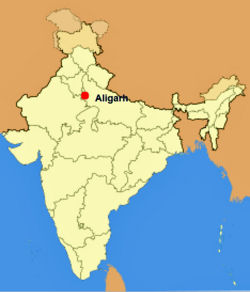Difference between revisions of "Aligarh"
(replace love to know link with wikipedia one) |
|||
| (One intermediate revision by one other user not shown) | |||
| Line 10: | Line 10: | ||
}} | }} | ||
{{Places of Interest|title=Aligarh|name=Aligarh |link=xxxxx}} | {{Places of Interest|title=Aligarh|name=Aligarh |link=xxxxx}} | ||
| − | |||
'''Aligarh''', also known as '''Koil''', was the headquarters of [http://dsal.uchicago.edu/reference/gazetteer/pager.html?objectid=DS405.1.I34_V05_215.gif Aligarh District] in the Meerut Division of United Provinces during the British period. It is situated about 75 miles south-east of [[Delhi]]. Aligarh's Civil Station lay north-east of the city. The old cantonment was abolished in 1869 and the old cemetery from 1802 is near the fort. | '''Aligarh''', also known as '''Koil''', was the headquarters of [http://dsal.uchicago.edu/reference/gazetteer/pager.html?objectid=DS405.1.I34_V05_215.gif Aligarh District] in the Meerut Division of United Provinces during the British period. It is situated about 75 miles south-east of [[Delhi]]. Aligarh's Civil Station lay north-east of the city. The old cantonment was abolished in 1869 and the old cemetery from 1802 is near the fort. | ||
| Line 21: | Line 20: | ||
== Spelling Variants == | == Spelling Variants == | ||
Modern name: Aligarh<br> | Modern name: Aligarh<br> | ||
| − | Variants: Alighur/Aligurh/Allygurh/Alliegurh | + | Variants: Alighur/Aligurh/Allyghur/Allygurh/Alliegurh |
==Railways== | ==Railways== | ||
| Line 36: | Line 35: | ||
== External Links == | == External Links == | ||
[http://dsal.uchicago.edu/reference/gazetteer/pager.html?objectid=DS405.1.I34_V05_225.gif Aligarh City] Imperial Gazetteer<br> | [http://dsal.uchicago.edu/reference/gazetteer/pager.html?objectid=DS405.1.I34_V05_225.gif Aligarh City] Imperial Gazetteer<br> | ||
| − | + | ===Historical books online=== | |
| + | *[https://books.google.com.au/books?id=9HkOAAAAQAAJ&pg=PP5 ''Anecdotes and Reminiscences of Service in Bengal''] [by A. L. M. Phillips (Alfred Lisle March Phillips) 1878] Google Books. He arrived in India in 1846 and retired 1873. The author was appointed Civil and Criminal Judge of Allyghur at the end of 1866 (page 171). | ||
| + | {{#widget:Google PlusOne | ||
| + | |size=small | ||
| + | |count=true | ||
| + | }} | ||
[[Category:Locations]] | [[Category:Locations]] | ||
[[Category:Cities, towns and villages in Bengal Presidency]] | [[Category:Cities, towns and villages in Bengal Presidency]] | ||
Latest revision as of 03:46, 11 June 2019
| Aligarh | |
|---|---|

| |
| Presidency: Bengal | |
| Coordinates: | 27.893754°N 78.068142°E |
| Altitude: | 178 m (584 ft) |
| Present Day Details | |
| Place Name: | Aligarh |
| State/Province: | Uttar Pradesh |
| Country: | India |
| Transport links | |
| East Indian Railway Oudh and Rohilkhand Railway | |
| FibiWiki Maps | |
|---|---|
| See our interactive map of this location showing places of interest during the British period | |
| [xxxxx Aligarh] |
Aligarh, also known as Koil, was the headquarters of Aligarh District in the Meerut Division of United Provinces during the British period. It is situated about 75 miles south-east of Delhi. Aligarh's Civil Station lay north-east of the city. The old cantonment was abolished in 1869 and the old cemetery from 1802 is near the fort.
Contents
Military history
Spelling Variants
Modern name: Aligarh
Variants: Alighur/Aligurh/Allyghur/Allygurh/Alliegurh
Railways
Aligarh was a junction between the main line of the East Indian Railway and a branch of the Oudh and Rohilkhand Railway.
Murrays Handbook 1933
Murrays 1933 Handbook lists the following for Aligarh:
Dak Bungalow: Kellner's Refreshments and Sleeping Rooms
Bank: Imperial Bank
Missions: American Methodist Episcopal, R.C., and C.M.S. Church
Petrol Stores and Motor Accessories: Edulji Bottlewala, Railway Road
External Links
Aligarh City Imperial Gazetteer
Historical books online
- Anecdotes and Reminiscences of Service in Bengal [by A. L. M. Phillips (Alfred Lisle March Phillips) 1878] Google Books. He arrived in India in 1846 and retired 1873. The author was appointed Civil and Criminal Judge of Allyghur at the end of 1866 (page 171).